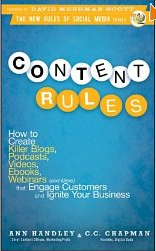 How do you find your voice and create your brand story so that readers are inspired and emotionally triggered? How do you get content marketing results?
How do you find your voice and create your brand story so that readers are inspired and emotionally triggered? How do you get content marketing results?
This and other key tips will be discussed Wednesday April 20, 2011 on an open webinar I’m giving:
Time-Saving Tips for Content Marketing Results
Register to get the recording if you can’t come at 5 pm ET, plus I’ll send you handouts, a list of outsourcing resources, a marketing road map and discount coupons for services.
“Before you can truly understand your customers, you have to understand yourself,” says author and content-marketing evangelist Joe Pulizzi.
If you are a coach, doctor, lawyer, any professional, you are trying to differentiate yourself in a crowded market. There are a gazillion websites in your field. To succeed, you need to forge a separate and unique identity and create an enduring and memorable brand.
You need a brand story. You need a brand personality. You need to stop sounding like everyone else.
I think this is one of the hardest things for busy professionals to communicate in writing content for the Web.
Why? Because it involves personal creativity. It’s one thing to write what you know. You can type 350 words of knowledge into your blog post in about 10 minutes or less. That’s the easy piece.
Don’t believe me? Come on, you explain stuff on the phone to clients all the time. Read More→










